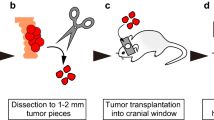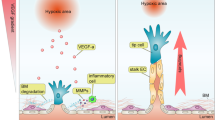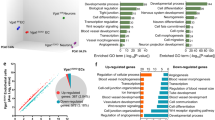Abstract
The mouse embryo hindbrain is a robust and adaptable model for studying sprouting angiogenesis. It permits the spatiotemporal analysis of organ vascularization in normal mice and in mouse strains with genetic mutations that result in late embryonic or perinatal lethality. Unlike postnatal models such as retinal angiogenesis or Matrigel implants, there is no requirement for the breeding of conditional knockout mice. The unique architecture of the hindbrain vasculature allows whole-mount immunolabeling of blood vessels and high-resolution imaging, as well as easy quantification of angiogenic sprouting, network density and vessel caliber. The hindbrain model also permits the visualization of ligand binding to blood vessels in situ and the analysis of blood vessel growth within a natural multicellular microenvironment in which endothelial cells (ECs) interact with non-ECs to refine the 3D organ architecture. The entire procedure, from embryo isolation to imaging and through to results analysis, takes approximately 4 d.
This is a preview of subscription content, access via your institution
Access options
Subscribe to this journal
Receive 12 print issues and online access
$259.00 per year
only $21.58 per issue
Buy this article
- Purchase on Springer Link
- Instant access to full article PDF
Prices may be subject to local taxes which are calculated during checkout





Similar content being viewed by others
References
Fantin, A. et al. Tissue macrophages act as cellular chaperones for vascular anastomosis downstream of VEGF-mediated endothelial tip cell induction. Blood 116, 829–840 (2010).
Ruhrberg, C. et al. Spatially restricted patterning cues provided by heparin-binding VEGF-A control blood vessel branching morphogenesis. Genes Dev. 16, 2684–2698 (2002).
Gerhardt, H. et al. VEGF guides angiogenic sprouting utilizing endothelial tip cell filopodia. J. Cell. Biol. 161, 1163–1177 (2003).
Raab, S. et al. Impaired brain angiogenesis and neuronal apoptosis induced by conditional homozygous inactivation of vascular endothelial growth factor. Thromb. Haemost. 91, 595–605 (2004).
Gerhardt, H. et al. Neuropilin-1 is required for endothelial tip cell guidance in the developing central nervous system. Dev. Dyn. 231, 503–509 (2004).
Vieira, J.M., Schwarz, Q. & Ruhrberg, C. Selective requirements for NRP1 ligands during neurovascular patterning. Development 134, 1833–1843 (2007).
Graupera, M. et al. Angiogenesis selectively requires the p110α isoform of PI3K to control endothelial cell migration. Nature 453, 662–666 (2008).
Lu, X. et al. The netrin receptor UNC5B mediates guidance events controlling morphogenesis of the vascular system. Nature 432, 179–186 (2004).
Abramsson, A. et al. Defective N-sulfation of heparan sulfate proteoglycans limits PDGF-BB binding and pericyte recruitment in vascular development. Genes Dev. 21, 316–331 (2007).
Tammela, T. et al. VEGFR-3 controls tip-to-stalk conversion at vessel fusion sites by reinforcing Notch signalling. Nat. Cell Biol. 13, 1202–1213 (2011).
Pitulescu, M.E., Schmidt, I., Benedito, R. & Adams, R.H. Inducible gene targeting in the neonatal vasculature and analysis of retinal angiogenesis in mice. Nat. Protoc. 5, 1518–1534 (2010).
Fruttiger, M. Development of the retinal vasculature. Angiogenesis 10, 77–88 (2007).
Carmeliet, P. et al. Impaired myocardial angiogenesis and ischemic cardiomyopathy in mice lacking the vascular endothelial growth factor isoforms VEGF164 and VEGF188. Nat. Med. 5, 495–502 (1999).
Kawasaki, T. et al. A requirement for neuropilin-1 in embryonic vessel formation. Development 126, 4895–4902 (1999).
Ruhrberg, C. Growing and shaping the vascular tree: multiple roles for VEGF. BioEssays 25, 1052–1060 (2003).
Nagy, A. Cre recombinase: the universal reagent for genome tailoring. Genesis 26, 99–109 (2000).
Ferrara, N. et al. Heterozygous embryonic lethality induced by targeted inactivation of the VEGF gene. Nature 380, 439–442 (1996).
Carmeliet, P. et al. Abnormal blood vessel development and lethality in embryos lacking a single VEGF allele. Nature 380, 435–439 (1996).
Schwarz, Q. et al. Vascular endothelial growth factor controls neuronal migration and cooperates with Sema3A to pattern distinct compartments of the facial nerve. Genes Dev. 18, 2822–2834 (2004).
Sawamiphak, S., Ritter, M. & Acker-Palmer, A. Preparation of retinal explant cultures to study ex vivo tip endothelial cell responses. Nat. Protoc. 5, 1659–1665 (2010).
Laitinen, L. Griffonia simplicifolia lectins bind specifically to endothelial cells and some epithelial cells in mouse tissues. Histochem J 19, 225–234 (1987).
Sorokin, S.P. & Hoyt, R.F. Jr. Macrophage development: I. Rationale for using Griffonia simplicifolia isolectin B4 as a marker for the line. Anat. Rec. 232, 520–526 (1992).
Albelda, S.M., Muller, W.A., Buck, C.A. & Newman, P.J. Molecular and cellular properties of PECAM-1 (endoCAM/CD31): a novel vascular cell-cell adhesion molecule. J. Cell Biol. 114, 1059–1068 (1991).
Brennan, C. & Fabes, J. Alkaline phosphatase fusion proteins as affinity probes for protein localization studies. Sci. STKE 2003, PL2 (2003).
Zudaire, E., Gambardella, L., Kurcz, C. & Vermeren, S. A computational tool for quantitative analysis of vascular networks. PLoS ONE 6, e27385 (2011).
Cumming, G., Fidler, F. & Vaux, D.L. Error bars in experimental biology. J. Cell Biol. 177, 7–11 (2007).
Gu, C. et al. Neuropilin-1 conveys semaphorin and VEGF signaling during neural and cardiovascular development. Dev. Cell. 5, 45–57 (2003).
Maden, C.H. & Ruhrberg, C. The murine hindbrain as a model to study the molecular and cellular mechanisms of angiogenesis in intact tissues. in The Textbook of Angiogenesis and Lymphangiogenesis. (eds. Zudaire, E. & Cuttita, F.) 205–216. (Springer, 2012).
Acknowledgements
We thank the staff of the Biological Resources Unit at the UCL Institute of Ophthalmology for help with mouse husbandry and the Imaging Facility of the UCL Institute of Ophthalmology for maintenance of the confocal microscopes. The protocol described in this manuscript was developed with funding from the Wellcome Trust (095623/Z/11/Z) and the Medical Research Council (MRC) (project grant G0601093) to C.R. and PhD studentships from the British Heart Foundation to A.F. (ref. 44626) and A.P. (ref. FS/10/54/28680), as well as a PhD studentship from the MRC to C.H.M. (G0700020).
Author information
Authors and Affiliations
Contributions
A.F., A.P., C.H.M. and C.R. prepared the figures and Supplementary Videos 1 and 2. All authors contributed to the development of the protocol and wrote the manuscript.
Corresponding author
Ethics declarations
Competing interests
The authors declare no competing financial interests.
Supplementary information
Supplementary Figure 1
Histochemical IB4 staining of an E12.5 mouse embryo hindbrain. An E12.5 hindbrain was labelled with biotinylated IB4 followed by HRP-conjugated streptavidin, flatmounted and imaged at the indicated magnifications. (a-c) Flatmounting the hindbrain with the pial side up allows visualisation of radial vessels entering the brain. (d-f) Flatmounting the hindbrain with the ventricular side up allows visualisation of the subventricular vascular plexus. The dotted boxes in (a,d) indicate the areas shown at higher magnification in (b,e), the dotted boxes in (b,e) those shown at higher magnification in (c,f), respectively; the size of each field in (c,f) is 500 μm x 500 μm, i.e. 0.25 mm2. (g,h) Counting of radial vessels and vascular intersections in the fields shown in (c,f); green dots were used to track vessels that have been counted. (i,j) A 100 μm transverse vibratome section through the E12.5 hindbrain shown in (a); radial vessels (rv) extend from the pial side of the hindbrain and form the SVP on the ventricular side; the boxed area in (i) is shown at a higher magnification in panel (j). Scale bars: (a,d) − 1 mm; (b,e,i) − 200 μm, (c,f) - 100 μm. All animal procedures were performed in accordance with institutional and UK Home Office guidelines. (PDF 1660 kb)
Supplementary Figure 2
Dissection of an E11.5 wild type mouse embryo hindbrain. Selected snapshots from supplemental movie 1 demonstrate key steps in hindbrains dissection. An E 11.5 embryo is decapitated roughly at shoulder height (a), and the anterior part of the head is removed (b). The hindbrain is revealed after peeling away the dorsal skin and hindbrain roof-plate membrane (c), allowing the hindbrain to unfurl (d-f). Next, the non-neural tissue underneath the hindbrain is peeled away (g,h). Finally, the hindbrain is trimmed to remove the spinal cord (i) and midbrain (j). The ventricular (k) and pial side (l) of the dissected hindbrain are shown. All animal procedures were performed in accordance with institutional and UK Home Office guidelines. (PDF 4927 kb)
Supplementary Video 1
Dissection of an E11.5 wild type mouse embryo hindbrain. This movie shows the procedure for dissecting an E11.5 hindbrain from a wild type mouse; the same procedure should be followed to dissect embryos at E12.5 or genetically altered mouse embryos at E11.5 or E12.5. Please turn on the sound to listen to an accompanying commentary explaining the dissection stages. All animal procedures were performed in accordance with institutional and UK Home Office guidelines. (MPG 26776 kb)
Supplementary Video 2
Dissection of an E11.5 Tie2-Cre;Nrp1fl/− mouse hindbrain. This movie shows the dissection of an E11.5 hindbrain from a Tie2-Cre;Nrp1fl/− mouse embryo that lacks NRP1 in endothelial cells. Note that vascular malformations can be observed already during the dissection procedure. All animal procedures were performed in accordance with institutional and UK Home Office guidelines. (MPG 29014 kb)
Rights and permissions
About this article
Cite this article
Fantin, A., Vieira, J., Plein, A. et al. The embryonic mouse hindbrain as a qualitative and quantitative model for studying the molecular and cellular mechanisms of angiogenesis. Nat Protoc 8, 418–429 (2013). https://doi.org/10.1038/nprot.2013.015
Published:
Issue Date:
DOI: https://doi.org/10.1038/nprot.2013.015
This article is cited by
-
Human organoids in basic research and clinical applications
Signal Transduction and Targeted Therapy (2022)
-
Hierarchical imaging and computational analysis of three-dimensional vascular network architecture in the entire postnatal and adult mouse brain
Nature Protocols (2021)
-
Retinoblastoma cell-derived exosomes promote angiogenesis of human vesicle endothelial cells through microRNA‐92a-3p
Cell Death & Disease (2021)
-
RIPK3 modulates growth factor receptor expression in endothelial cells to support angiogenesis
Angiogenesis (2021)
-
The C5a/C5a receptor 1 axis controls tissue neovascularization through CXCL4 release from platelets
Nature Communications (2021)
Comments
By submitting a comment you agree to abide by our Terms and Community Guidelines. If you find something abusive or that does not comply with our terms or guidelines please flag it as inappropriate.



